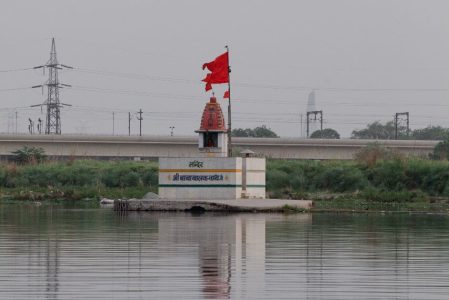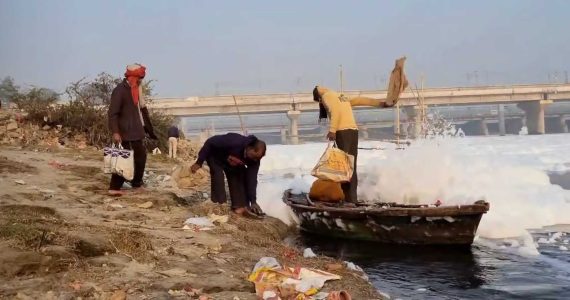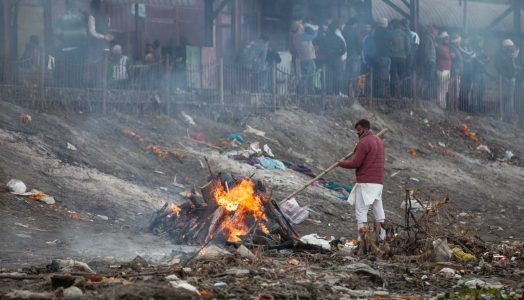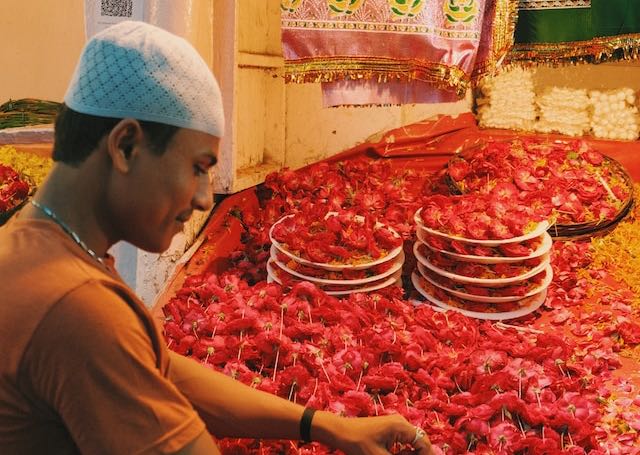 Rivers are lifelines; in India, they are sacred, holy and worshipped by millions. Yet, it is the people and their actions that, over decades, is polluting these sacred rivers. Souzeina Mushtaq and Praveen K. Chaudhry have been visiting the Yamuna river at Ghat 24 in Delhi for several years, and discuss some of the issues — and hopes — in this final ‘India at 75’ post.
Rivers are lifelines; in India, they are sacred, holy and worshipped by millions. Yet, it is the people and their actions that, over decades, is polluting these sacred rivers. Souzeina Mushtaq and Praveen K. Chaudhry have been visiting the Yamuna river at Ghat 24 in Delhi for several years, and discuss some of the issues — and hopes — in this final ‘India at 75’ post.
Throughout history, rivers have been crucial to the birth of civilisations. In the Indian subcontinent, the mighty civilisations of Mohenjo-Daro and Harappa came up along the Indus, Sutlej, and the riverbanks of the ancient Saraswati rivers in the north; in southern India, they developed around the Godavari, Krishna, and Kaveri rivers.
Rivers are so integral to the identity of the Indian subcontinent that even the English name of the country derives from the river Indus, ‘India’ being the Greek and Latin term for the country of the river Indus, which emerges in the mountain springs of Mount Kailash in western Tibet, then flowing through Kashmir and Pakistan, empties into the Arabian Sea near the port city of Karachi.
India has about ten perennial rivers (those that maintain their flow through the year), mainly in the north; but most of them are now turning seasonal, with fragmented and intermittent flows. And India is not the only place where this is happening: in the United States, some of the most endangered rivers are the Upper Mississippi and Lower Missouri, whose combined basins span nine states across the Midwest.
*
Rivers in India are classified on the basis of their sources of origin: (1) Himalayan; and (2) Peninsular rivers. The major Himalayan rivers are the Indus, Ganga, Yamuna and Brahmaputra; the Peninsular ones are the Mahanadi, Godavari, Krishna and Kaveri.
Rivers in India are holy for Hindus, who worship them. Prime Minister Narendra Modi launched his election campaign in 2014 from the banks of the river Ganga in the city of Varanasi, declaring that he had been called on by ‘Mother Ganga’ to restore the river, considered the holiest of all rivers by millions of Hindus.

Photo 1: A temple along the banks of the Yamuna river (across from Ghat 24) in Delhi, 2022 © Copyright information below
Polluting the Sacred
Yet, India’s rivers remain the most polluted. The Citizen’s Fifth Report (1999) states:
India has had a multi-millennial tradition of worshipping rivers. Even though Hindu scholars will not get tired of extolling the ecological elements of Hinduism, of which there are many, there is, nonetheless, the disparity between the word and the deed. Indians, including the river-worshipping Hindus, do not think twice before polluting a river.
But this is not a recent phenomenon. In 1997, journalist Samar Halarnkar wrote about what he called ‘the rivers of death’: ‘Once symbols of purity and life for India’s teeming millions, India’s rivers are today foul receptacles of sewage and toxic waste. If the poisoning of our rivers is not stopped, more disease and death seem inevitable.’
In 2018, one of India’s leading environmentalists died while protesting against the establishment of hydroelectric projects on the Ganga and its tributaries, and illegal sand-mining activities. Guru Das Agrawal was a former Professor of Environmental Engineering at the Indian Institute of Technology in Kanpur; having studied at UC-Berkeley, he was latterly the first Head of the Central Pollution Control Board (CPCB) of India. In June 2018, he started an 111-day hunger strike, hoping it would compel the Indian government to work on its promise of cleaning up the Ganga. In his letter to Prime Minister Narendra Modi, Agrawal wrote:
in the past four years, all actions undertaken by your government have not at all been gainful to Ganga and, in her place, gains are to be seen only for the corporate sector and several business houses.

Photo 2: Illegal sand-mining on Yamuna river (across from Ghat 24) in Delhi, 2022 © Copyright information below
Himanshu Thakkar, a river expert and coordinator of the South Asia Network on Dams, Rivers and People, a non-profit organisation based in New Delhi, too believes that commerce has been prioritised over conservation.
Both Agrawal and Thakkar were referring to the several projects initiated by successive governments— including waterways, riverfront development, dredging, and interlinking of rivers — that have adversely affected the Ganga.
Yamuna: Ghat 24
Yamuna (the twin sister of Yama, the god of death), a principal tributary of the sacred Ganga and one of the holy rivers in India, is crying for help. Alongside the Ganga, the Yamuna is often depicted at the entrance of Hindu sacred precincts or on sanctuary door-jambs to ensure that the visitor is symbolically purified before entering the premises. She is portrayed as a handsome woman carrying a blue lotus, a fly-whisk, and a water pot. Her mount is a tortoise because many still live, or used to live, in her waters.
In late 2021, a layer of toxic foam coated parts of the Yamuna near Delhi, the capital of India, as Hindus gathered on its banks to celebrate Chhath Puja, a festival dedicated to the Hindu sun god Surya, when fasting women offer ‘arghya’ (a Vedic practice of offering water to the sun in the morning) standing in knee-deep waters. The white froth, a mixture of sewage and industrial waste, formed in sections of the Yamuna river, which flows about 855 miles (ca 1,376 kilometres) south from the Himalayas through several Indian states. According to news reports, the pungent foam contained high levels of ammonia and phosphates, which can cause respiratory and skin problems. Many devotees were seen wading through the toxic foam to bathe and pray in the river despite this deadly pollution. CNN interviewed Gunjan Devi, who said she had no choice but to bathe in the polluted waters: ‘The water is extremely dirty, but we don’t have many options. It is a ritual to bathe in a water body, so we have come here to bathe.’ According to the Press Trust of India, 15 boats were deployed by the government to remove the foam, but significant damage had already been done.

Photo 3: Toxic industrial foam on Yamuna river (Okhla Barrage), 2021 © Waqar Khan; used with permission by authors.
Delhi-based environmentalist Vimlendu Jha says that the lack of political will, zero urgency in cleaning the Yamuna, and minimal action on the ground were reasons behind the frequent foaming in the river. In a news report in Outlook magazine in 2022, Jha was quoted as saying: ‘Delhi empties more than 3,500 million litres of municipal sewage in the river and, despite tall claims, over 50 per cent of the sewage is either untreated or not adequately treated and flows directly into the Yamuna …. Lack of minimum flow in the river is another major cause of the Yamuna’s pollution.’
Bhavreen Kandhari, another environmentalist, also felt that toxic foam-covered sections of the river are due to the negligence and absence of real action on the ground: ‘On the Yamuna, scores of farmhouses and industries are discharging pollutants into the river. There are about 92 drains that open directly into Yamuna, out of which 62 are untapped.’
For decades, sections of the Yamuna have been plagued by the dumping of toxic chemicals and untreated sewage. As a result, the river appears dark and sludgy in several parts, while plastic waste lines its banks.
*
Industrial waste is among India’s top sources of pollution in rivers. The discharge from industries is directly pumped into the rivers without treatment, affecting aquatic life and humans. Eutrophication is another factor impacting rivers in India today, often induced due to improper agricultural practices and city sewage discharge into the rivers. It leads to overgrowth of plants and algae in aquatic ecosystems and can render a water body unusable for various activities, from fishing to swimming to drinking water.
The most pronounced effect of eutrophication is the creation of dense blooms of noxious, foul-smelling phytoplankton that reduce water clarity and harm water quality. Additionally, algal blooms limit the penetration of light, reducing growth and causing die-offs of plants in littoral zones while lowering the success of predators that need light to pursue and catch prey. High rates of photosynthesis are also associated with eutrophication, which can deplete dissolved inorganic carbon and raise pH to extreme levels during the day. Elevated pH can, in turn, ‘blind’ organisms that rely on the perception of dissolved chemical cues for survival by impairing their chemosensory abilities. When these dense algal blooms eventually die, microbial decomposition severely depletes dissolved oxygen, creating a ‘dead zone’ which lacks sufficient oxygen to support most organisms.
*
Some social and religious practices also harm the rivers — including dumping dead bodies, and other sacred detritus (like flowers, remainders of incense, food offerings used in private/domestic rituals, often tied in plastic bags) in the water. In 2021, thousands of dead bodies were found floating in the Yamuna during the country’s deadly second wave of Coronavirus which killed more than 120,000 people. The Ganga and Yamuna rivers passed through some of India’s worst-hit Covid-19 regions; according to news reports, fear of Covid-19 led villagers to dump dead bodies in the river instead of cremating them.

Photo 4: Cremation pyre on the banks of the Yamuna river, Nigambodh Ghat (Ghat 24), Delhi, 2022 © Copyright information below.
Festivals like Ganapati Puja (also known as Ganesh Chaturthi), commemorating the birth of the Hindu god Ganesh, are among major pollutants of rivers in India, including the Yamuna. The festival is celebrated with the installation of Ganesh’s clay idols in people’s homes, and in community pandals (temporary cloth tents ), eventually immersing the idols in the water bodies at the end of the festival.
In earlier years, idols were made with clay and coloured with natural colours (like turmeric) and worshipped with natural products like coconut, yogurt, milk and water. Nowadays, they are made mostly with a mixture of Plaster of Paris (PoP) and clay, with small iron rods and bamboo stuffing, and decorated with different paints including varnish, water colours, etc. When these are immersed in water, it increases pollution in water bodies.
The CPCB studied the impact of the immersion of Ganesh idols in India, and concluded that water quality had depleted, acid content had increased, the Total Dissolved Solids had increased by 100%, and oxygen levels had reduced. In addition, heavy metal particles (like iron and copper) had risen ten-fold in the composition of the water.
In 2021, the Delhi Pollution Control Committee (DPCC; the pollution controlling body of the Delhi state government) issued guidelines to District Magistrates to ensure that idols are not immersed in the Yamuna or any other water body in the national capital. Violations would be punishable with a fine of ₹ 50,000 (US$605 approx.) or a jail term of up to six years. To respect the tradition of immersing idols in water, DPCC asked urban local bodies to create artificial ponds near residential areas for the immersion of idols.
Rivers as Humans
In 2017, a court in the northern Indian state of Uttarakhand ordered that the Ganga and its main tributary, the Yamuna, be accorded the status of living human entities, which would mean that polluting or damaging the rivers will be legally equivalent to harming/killing a person. The judges cited the example of the Whanganui River (revered by the indigenous Maori people, which was declared a living entity with full legal rights by the New Zealand government in August 2017).
Indian courts and environmentalists have been critical of three decades of government efforts to clean up the holy rivers. The last clean-up initiative deadline was set for 2018, which was never met.
The Yamuna Action Plan (YAP), a river restoration project, was introduced in 1993 to restore the river. It was a bilateral project between the governments of India and Japan, where Japan offered loan assistance to implement YAP. Subsequently, two phases (YAP II and YAP III) were initiated in 2004 and 2008 respectively. To clean the Yamuna River, ₹1,500 crore (US$150 million) was spent on the YAP, and a plan of ₹1,174 crore (US$11.74 billion) was redrawn, while ₹460 crore (US$ 4.6 billion) had been given for cleaning Yamuna under the ‘Namami Gange Programme’, an Integrated Conservation Mission approved as a Flagship Programme by the Central Government of India. But the Yamuna has remained the same, and in fact has got worse, according to reports.
But unfortunately, the mission to clean Ganga and Yamuna (including YAP) has failed according to the Parliamentary Committee on Environment and Forests of the Government of India.
*
Something miraculous happened to the Yamuna as the world receded inside their homes during lockdown following the Covid-19 pandemic in 2020. According to DPCC findings, the Yamuna became 33 per cent cleaner than before. Environment Conservator Diwan Singh said the rivers cleaned themselves due to their biological potential.
Yamuna is most polluted in areas surrounding Delhi, owing to the city’s dense population and high levels of waste. The Delhi stretch of the Yamuna river is about 22 kms (13 miles approx.), starting from Wazirabad Barrage to Okhla Barrage, which accounts for 2 per cent of the river’s length that flows through the capital. Yet, this stretch alone is responsible for 76 per cent of the river’s pollution. Around 90 per cent of untreated wastewater from households pours into the river. This wastewater comprises laundry detergents and other chemicals, increasing the water’s phosphate content and leading to froth formation. Not only that, but this stretch is also the primary source of 70 per cent of Delhi’s water supply, serving roughly 57 million people.
Earlier this year, a high-level committee constituted by the National Green Tribunal (NGT) for the rejuvenation of the Yamuna chalked out a six-month action plan till June 2023, with monthly targets. The committee stressed time-bound actions on ‘right parameters’ that include enhancement of sewage-treatment capacity in Delhi and the augmentation of Sewage Treatment Plants, tapping of drains and treatment of sewage in 44 sub-drains, extension of the sewage network in all 1,799 unauthorised colonies in Delhi and surrounding areas, upgrade of 13 Common Effluent Treatment Plants (CETP) for treatment, management of industrial effluents and ensuring minimum environmental flow in the Yamuna using inter-state coordination.
Only time will tell whether these measures will be implemented and succeed, and whether Yamuna will revive and flow perennially again. For now, one can only hope.
*
The views expressed here are those of the author and not of the ‘South Asia @ LSE’ blog, the LSE South Asia Centre or the London School of Economics and Political Science. Please click here for our Comments Policy.
Photographs © Praveen K. Chaudhry (except Photo 3); no photograph may be used/reproduced without written permission of the authors; Banner image © Praveen K. Chaudhry, Yamuna river at Ghat 24, 2023.
This blogpost may not be reposted by anyone without prior written consent of LSE South Asia Centre; please e-mail southasia@lse.ac.uk for permission.
The ‘India @ 75’ logo is copyrighted by the LSE South Asia Centre, and may not be used by anyone for any purpose. It shows the national flower of India, the Lotus (Nelumbo nucifera [Gaertn.]), framed in a graphic design of waves, and spindles depicting depth of water. The logo has been designed by Oroon Das.
*








Interesting.
As the song goes, “What Nature doesn’t do to us will be done by our fellow man.”